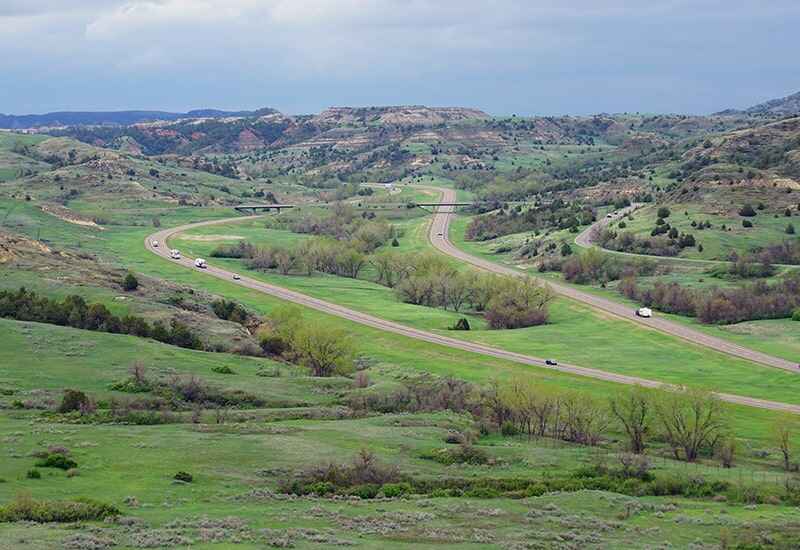
Moving. Simplified.
When you are serious about moving to Fargo, North Dakota, you may be curious to know how living in the city will be. You may come across different opinions and suggestions, especially related to living costs, safety, education, jobs, and lifestyle. However, most of the information would be contradicting, putting you in a more confused state. But luckily, our Fargo moving guide is there for your rescue
You’ll find every piece of information related to every aspect of Fargo, a mid-sized city in eastern North Dakota that shares a border with Minnesota along the Red River. The city is a great place to work and live. It scores high in many index lists and embraces every newcomer wholeheartedly.
Here’s all you need to know about Fargo, North Dakota before you make the final call.

Fargo takes pride in its splendid outdoor and spectacular green spaces complemented with a list of amazing festivals spread across the calendar. The state also boasts of a strong and diverse economy and this ensures that you have a comfortable life, both professionally and personally. Even the living cost at Fargo is much lower than the national average. Moving to Fargo, you are sure to have a life more comfortable than at the previous place.
A city with a strong cultural base, Fargo is home to many art museums and also hosts several art festivals around the year. The city in North Dakota is also pristine with many outdoor recreation options. This means, you live in a city where there is no scarcity of fun and entertainment. Living in the city, you’ll realize that the economy is strong and diverse, which means it is easier to find a job in Fargo than most of the North Dakota cities. However, crime rate is the only major concern in Fargo.
Fargo has a majority white population (81%) but the racial diversity is also strong here. About 7.83% of the residents in Fargo belong to Black or African American community while 4.12% are Asians and 2.31% are Non-Hispanics. This means, almost every race has a strong presence in Fargo and irrespective of your racial background, you will be welcomed here.
Considering the cost for gas, groceries, utilities, and transport, Fargo is little more expensive than the rest of North Dakota cities. Moving to Fargo, you may need to spend approximately $1,598 which makes the city in the top 26% of the expensive cities in the world. However, the cost of living here is much lower than the US average. You can purchase a home at a cost 17% lower than the national average. Similarly, the utilities in this North Dakota city cost 9% lower than the US average.
The city of Fargo has a population of 125,990, as per the 2020 census. The population density was 2,162.0 inhabitants per square mile. The Fargo metro area population is 252,136, making it the 192nd most populated metro area in the US. The median age in Fargo is 30.3, the US median age is 37.4 and there are 9,956 housing units in the city limits.
To know more about the city population, here is a quick breakdown
While residing at Fargo, you’d spend less time on the road as the average commuting time in Fargo is much lower than the national average. The average one-way commute in Fargo takes 15.0 minutes against the US average of 26.4 minutes.
Here’s how people in Fargo commute on a daily basis
Tip: While moving the home, safety of your belongings is the priority and you need a trustworthy mover at your side. Know the top-rated moving companies in Fargo, ND.
Fargo has an extreme humid continental climate where winters are extremely cold and harsh and summers are hot and humid. The most pleasant months in Fargo are June, July and August. It is good to know the important aspects of weather in Fargo before you pack your bags.

You would have noticed that a lot of people are moving to Fargo. Have you ever wondered why? We’ve got the reasons

Moving to Fargo has got its own share of merits and demerits. It is vital you know them before making the final call. Here is a list of pros and cons of moving to Fargo.

| Rank | City | Population | Home Value |
|---|---|---|---|
| 1 | Longfellow | 2,625 | $292,961 |
| 2 | Rose Creek | 832 | $440,300 |
| 3 | Southpointe | 4,060 | $244,316 |
| 4 | Stonebridge | 5,058 | $236,000 |
| 5 | Lincoln | 1,690 | $239,256 |
| 6 | Horace Mann | 2,286 | $176,982 |
| 7 | Centennial | 2,435 | $288,380 |
| 8 | Pointe West | 2,834 | $225,954 |
| 9 | Woodhaven | 2,432 | $333,282 |
| 10 | Trollwood | 2,497 | $110,509 |

If you are concerned about living costs in Fargo, you can smile as the living cost here is 6% lower than the national average.
The average cost of living in Fargo is $1,598, which though places the city among the expensive cities in the US is lower than most of the large neighboring cities in North Dakota and outside
Fargo is 84.5% cheaper than San Francisco, 54.5% cheaper than Washington DC, 78.8% cheaper than New York City, and 49.4% cheaper than Boston
The following is a simple breakdown of the key elements that make up the city’s cost of living since you’re considering moving to Fargo.
| Living Expense | Fargo | North Dakota | National Average |
|---|---|---|---|
| Overall | 91.9 | 89.9 | 100 |
| Grocery | 99.5 | 95.1 | 100 |
| Health | 85.5 | 92.4 | 100 |
| Housing | 96.4 | 88.5 | 100 |
| Median home cost | $252,900 | $240,200 | $291,700 |
| Utilities | 92.3 | 89.4 | 100 |
| Transportation | 77.3 | 74.4 | 100 |
| Miscellaneous | 98.3 | 108.3 | 100 |

Those who are moving to Fargo for job purposes may not like the fact that Fargo’s job growth is negative. Despite the diverse economy, the city may not be a good choice if job is the sole reason for moving.
Here are a few job stats in Fargo which you may find helpful
| Employment Information | Fargo, North Dakota | United States |
|---|---|---|
| The income per Cap | $31,866 | $31,177 |
| Household Income | $50,561 | $57,652 |
| Unemployment Rate | 3.6 | 6.0% |
| Recent Job Growth | -1.50% | -6.18% |
| Future Job Growth | 38.71% | 33.51% |
Tell us a little bit about your move and let us make your move simple.
Start My Quote NowDespite the negative job growth, there are a few jobs that are fast growing in Fargo. And if you are still serious about moving here, the following list of the 5 fastest growing jobs in Fargo and nearby areas in North Dakota will benefit you.
| Rank | Job Title | Growth % | Average Salary |
|---|---|---|---|
| 1 | Personal care assistant | 131.3% | $31,890 |
| 2 | Emergency medical technician | 130.1% | $31,960 |
| 3 | Software developer | 129.1% | $79,820 |
| 4 | Home health aid | 128.0% | $33,170 |
| 5 | Registered nurse | 124.4% | $60,840 |
Though it is true that Fargo’s job market is not showing positive signs, you may be still keen to relocate to the city. And you may also be keen to know the jobs that provide hefty paychecks. Do not worry as we’ve got a list of 10 top paying jobs
| Rank | Job Title | Average Salary | Entry level salary |
|---|---|---|---|
| 1 | Physicians and Surgeons, All Other | $236,560 | $151,250 |
| 2 | Dentists, General | $211,360 | $118,550 |
| 3 | Family and General Practitioners | $204,120 | $162,520 |
| 4 | Chief Executives | $181,120 | $81,160 |
| 5 | Education Administrators, Postsecondary | $128,340 | $51,730 |
| 6 | Business Teachers, Postsecondary | $128,030 | $55,410 |
| 7 | Computer and Information Systems Managers | $114,400 | $71,240 |
| 8 | Medical and Health Services Managers | $113,910 | $55,980 |
| 9 | Financial Managers | $113,390 | $66,550 |
| 10 | Architectural and Engineering Managers | $112,750 | $79,780 |
In Fargo, a good salary is $52,537, which may be higher than in many neighboring cities as the cost of living is also higher here. To help you get an idea about how much you need to earn to have a decent living in Fargo, we’ve collated the figures below.
As you reach Fargo, you'll be on the process of the job hunt, and having an idea about the companies with a good reputation will help you a lot. Here are the 10 best companies to work for in Fargo.
While preparing to relocate to Fargo, knowing the major industries here will help you decide whether finding a suitable job would be easier or not. Here’s a list of major industries in Fargo

In Fargo, the housing costs are much higher than the state average and hence, most people stay on rent. Only 47.7% of the population owns a house here while about 52.3% stay on rent. Knowing a little more about the housing market will give you an idea about residential facilities in Fargo. And we’ve collated a few housing stats for you
You would need a home on rent as soon as you reach Fargo. This is crucial when you are moving with the family. And having an idea about home rental in advance would make things easier

Knowing the different taxes levied by the administration in Fargo is crucial as they decide how much you save a month.
To help you, we’ve listed down the highlights of state tax in Fargo, North Dakota.

Fargo is one of the most beautiful places in North Dakota. Moving here, you’ll have no shortage of fun and entertainment.
Here are the 10 best things that will keep you busy and engaged during your stay in Fargo.

Safety is a crucial factor in residing at any place. And Fargo unfortunately does not rank high in safety. The city records a large number of crime cases, which seriously impact the safety of the residents. Here, we’ve got the latest crime data, based on which you can decide whether to move to Fargo.
Tip:Often, you feel like calculating the moving cost before you connect with a moving company. To help you, we've got a free moving cost calculator.

You may be highly concerned about your child’s education while moving to a new place and fortunately, that won’t be an issue at Fargo at all.
Long Fellow Elementary
Public, K-5 | 373 students
Kindred Elementary School
Public, K-5 | 488 students
Bennett Elementary School
Public, K-5 | 585 students
Centennial Elementary School
Public, K-5 | 521 students
Horace Elementary School
Public, K-5 | 251 students
Discovery Middle School
Public, 6-8 | 1,099 students
Ben Franklin Middle School
Public, 6-8 | 845 students
Cheney Middle School
Public, 6-8 | 1,092 students
Liberty Middle School
Public, 6-8 | 1,150 students
Carl Ben Eielson Middle School
Public, 6-8 | 732 students
Fargo Davies High School
Public, 9-12 | 1,328 students
North High School
Public, 9-12 | 1,001 students
West Fargo Sheyenne High School
Public, 9-12 | 1,561 students
Kindred High School
Public, 9-12 | 349 students
South High School
Public, 9-12 | 925 students
University of North Dakota
Rasmussen University
Concordia College
Franklin University
University of Mary – Fargo Campus
MoverJunction.com
20130 Lakeview Center Plaza
Ashburn, VA 20147
888-901-4841
